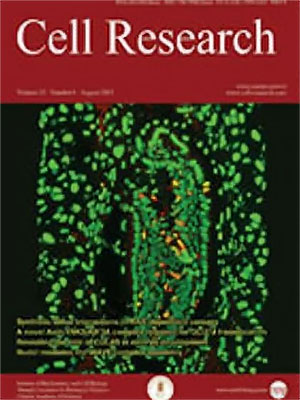
Volume 13, No 2, Apr 2003
ISSN: 1001-0602
EISSN: 1748-7838 2018
impact factor 17.848*
(Clarivate Analytics, 2019)
Volume 13 Issue 2, April 2003: 111-120
ORIGINAL ARTICLES
Interaction with general transcription factor IIF (TFIIF) is required for the suppression of activated transcription by RPB5-mediating protein (RMP)
Wenxiang WEI1,*, Jun Xia GU2 Cui Qing ZHU1, Feng Yan SUN1, Dorjbal DORJSUREN3, Yong LIN3, Seishi MURAKAMI3,**
1National Key Laboratory of Medical Neurobiology, Fudan University, 138 Yi Xue Yuan Road, Shanghai 200032, China
2Department of Hematology, the Affiliated Xiehe Hospital, Tongji Medical School, Huazhong University ofScience and Technology, 1277 Jiefang Avenue, Wuhan 430022, China
3Department of Molecular Oncology, Cancer Research Institute, Kanazawa University, Takara-machi 13-1,Kanazawa 920-0934, Japan
*Present address: Department of Biochemistry, University of Medicine and Dentistry of New Jersey, Robert Wood Johnson Medical School, Piscataway, NJ 08854, USA. Tel: 001-(732)235-4194. E-mail: weiwe@umdnj.com
Correspondence: Seishi MURAKAMI(semuraka@kenroku.ipc.kanazawa-u.ac.jp)
RMP was reported to regulate transcription via competing with HBx to bind the general transcription factor IIB (TFIIB) and interacting with RPB5 subunit of RNA polymerase II as a corepressor of transcription regulator. However, our present research uncovered that RMP also regulates the transcription through interaction with the general transcription factors IIF (TFIIF), which assemble in the preinitiation complex and function in both transcription initiation and elongation. With in vitro pull-down assay and Far-Western analysis, we demonstrated that RMP could bind with bacterially expressed recombinant RAP30 and RAP74 of TFIIF subunits. In the immunoprecipitation assay in COS1 cells cotransfected with FLAG-tagged RMP or its mutants, GST-fused RAP30 and RAP74 were co-immunoprecipitated with RMP in approximately equal molar ratio, which suggests that RAP30 and RAP74 interact with RMP as a TFIIF complex. Interestingly both RAP30 and RAP74 interact with the same domain (D5) of the C-terminal RMP of 118-amino-acid residuals which overlaps with its TFIIB-binding domain. Internal deletion of D5 region of RMP abolished its binding ability with both subunits of TFIIF, while D5 domain alone was sufficient to interact with TFIIF subunits. The result of luciferase assay showed that overexpression of RMP, but not the mutant RMP lacking D5 region, suppressed the transcription activated by Gal-VP16, suggesting that interaction with TFIIF is required for RMP to suppress the activated transcription. The interaction between RMP and TFIIF may be an additional passway for RMP to regulate the transcription, or alternatively TFIIF may cooperate with RPB5 and TFIIB for the corepressor function of RMP.
FULL TEXT | PDF
Browse 2039


